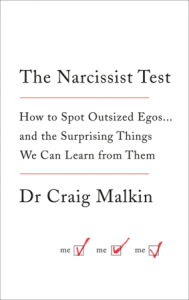In the December/January issue of HRM, Tomas Chamorro-Premuzic, (a speaker at AHRI’s national convention in 2015, who will be appearing at this year’s convention in Brisbane), held forth on how over-confident leadership can be disastrous for businesses.
Dr Craig Malkin, a clinical psychologist and Instructor of Psychology at Harvard Medical School, takes  up this theme in his new book, describing how, as an undergraduate learning about narcissism, it dawned on him that the description accurately described his own mother’s behaviour. “I remember feeling relieved and horrified all at once. The term perfectly captured the paradox of my mother.”
up this theme in his new book, describing how, as an undergraduate learning about narcissism, it dawned on him that the description accurately described his own mother’s behaviour. “I remember feeling relieved and horrified all at once. The term perfectly captured the paradox of my mother.”
Recognising and identifying the narcissists among us, as well as learning how to deal with them, is the subject of this book.
Malkin begins by airing claims that we are in the midst of a “narcissism epidemic,” fuelled by the influence of celebrity culture and social media. That image of a disease is what Malkin sets out to challenge: the idea that narcissism is wholly destructive and always harmful. Instead, he asserts that the drive to feel special is just a normal, pervasive human tendency that we all share. It’s the degree to which we need to feel special that determines whether narcissism is healthy or unhealthy.
When people grow dependent on feeling special, he says, they lose the capacity to see the world from any point of view other than their own. “These are the true narcissists, and at their worst, they also display two other traits of a so-called ‘dark triad’: a complete lack of remorse and a penchant for manipulation.”
Malkin is an engaging writer and the chapters on narcissism theory are far from dry. He’s also practical and involving, asking readers to measure their own narcissism by answering questions and scoring the answers. He explores, too, how gender and age impact upon our narcissistic impulses and how that changes over time. The book is full of case studies drawn from his past practice to help the reader identify and understand behaviours in themselves, close friends and family, and in their workplaces.
From an HR point of view, the chapter “Coping and Thriving,” dealing with colleagues and bosses, is perhaps the most helpful. Extreme narcissism often manifests itself in displays of bullying and disrespect, says Malkin, and he cites one of the few studies that has looked at how co-workers deal with it. Five tactics most frequently used are ignoring, confronting, befriending, quitting and informing management. “Those who relied on informing or quitting seemed pleased with how things turned out, but the same couldn’t be said for those who tried the other tactics. These strategies got them nowhere,” he says.
Malkin offers six “interventions” in dealing with narcissists at work, some of which attempt to nudge a narcissist down a notch while at the same time protecting yourself. He adds a caveat that these tactics will not work with people who have full-blown narcissistic personality disorder (NPD). “Where bad behaviour crosses the line and becomes abuse, the organisation, not the individual, bears responsibility for the problem. Bullying demands systemic and legal intervention.” Wise words.
It would certainly be entertaining to get Chamorro-Premuzic and Malkin on a stage together to debate their respective views.
This article is an edited version. The full article was first published in the February 2016 issue of HRMonthly magazine as ‘The Narcissist Test’. AHRI members receive HRMonthly 11 times per year as part of their membership. Find out more about AHRI membership here.

